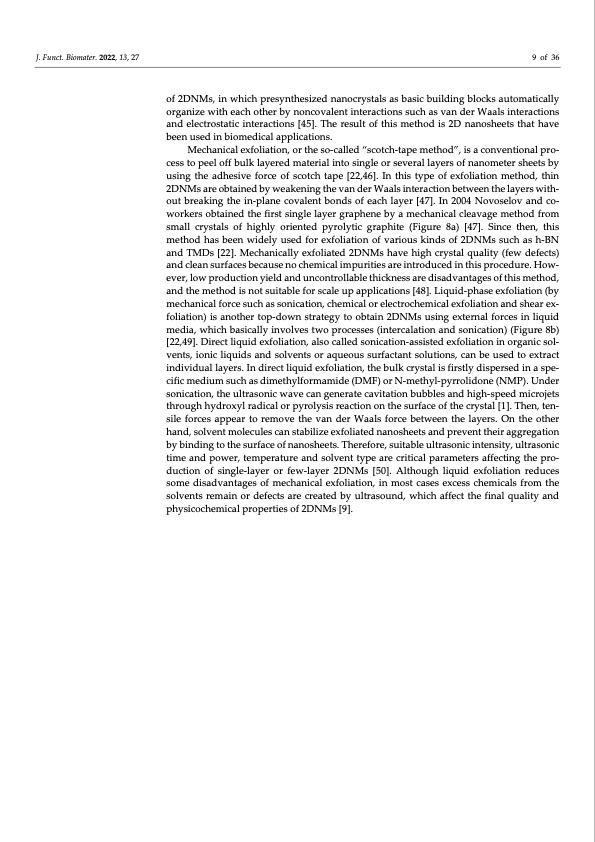
PDF Publication Title:
Text from PDF Page: 009
J. Funct. Biomater. 2022, 13, 27 9 of 36 of 2DNMs, in which presynthesized nanocrystals as basic building blocks automatically organize with each other by noncovalent interactions such as van der Waals interactions and electrostatic interactions [45]. The result of this method is 2D nanosheets that have been used in biomedical applications. Mechanical exfoliation, or the so-called “scotch-tape method”, is a conventional pro- cess to peel off bulk layered material into single or several layers of nanometer sheets by using the adhesive force of scotch tape [22,46]. In this type of exfoliation method, thin 2DNMs are obtained by weakening the van der Waals interaction between the layers with- out breaking the in-plane covalent bonds of each layer [47]. In 2004 Novoselov and co- workers obtained the first single layer graphene by a mechanical cleavage method from small crystals of highly oriented pyrolytic graphite (Figure 8a) [47]. Since then, this method has been widely used for exfoliation of various kinds of 2DNMs such as h-BN and TMDs [22]. Mechanically exfoliated 2DNMs have high crystal quality (few defects) and clean surfaces because no chemical impurities are introduced in this procedure. How- ever, low production yield and uncontrollable thickness are disadvantages of this method, and the method is not suitable for scale up applications [48]. Liquid-phase exfoliation (by mechanical force such as sonication, chemical or electrochemical exfoliation and shear ex- foliation) is another top-down strategy to obtain 2DNMs using external forces in liquid media, which basically involves two processes (intercalation and sonication) (Figure 8b) [22,49]. Direct liquid exfoliation, also called sonication-assisted exfoliation in organic sol- vents, ionic liquids and solvents or aqueous surfactant solutions, can be used to extract individual layers. In direct liquid exfoliation, the bulk crystal is firstly dispersed in a spe- cific medium such as dimethylformamide (DMF) or N-methyl-pyrrolidone (NMP). Under sonication, the ultrasonic wave can generate cavitation bubbles and high-speed microjets through hydroxyl radical or pyrolysis reaction on the surface of the crystal [1]. Then, ten- sile forces appear to remove the van der Waals force between the layers. On the other hand, solvent molecules can stabilize exfoliated nanosheets and prevent their aggregation by binding to the surface of nanosheets. Therefore, suitable ultrasonic intensity, ultrasonic time and power, temperature and solvent type are critical parameters affecting the pro- duction of single-layer or few-layer 2DNMs [50]. Although liquid exfoliation reduces some disadvantages of mechanical exfoliation, in most cases excess chemicals from the solvents remain or defects are created by ultrasound, which affect the final quality and physicochemical properties of 2DNMs [9].PDF Image | Nanomaterials beyond Graphene for Biomedical Applications

PDF Search Title:
Nanomaterials beyond Graphene for Biomedical ApplicationsOriginal File Name Searched:
jfb-13-00027.pdfDIY PDF Search: Google It | Yahoo | Bing
CO2 Organic Rankine Cycle Experimenter Platform The supercritical CO2 phase change system is both a heat pump and organic rankine cycle which can be used for those purposes and as a supercritical extractor for advanced subcritical and supercritical extraction technology. Uses include producing nanoparticles, precious metal CO2 extraction, lithium battery recycling, and other applications... More Info
Heat Pumps CO2 ORC Heat Pump System Platform More Info
| CONTACT TEL: 608-238-6001 Email: greg@infinityturbine.com | RSS | AMP |